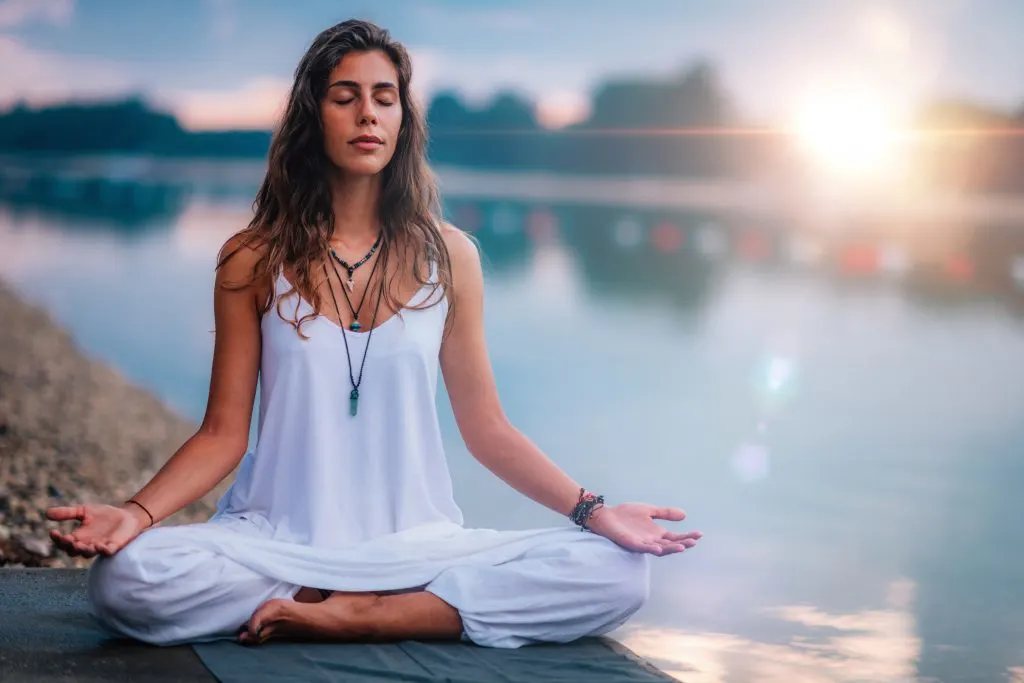Chances are you’ve heard of meditation, and may have even tried it. But have you ever thought of how meditation is different from daydreaming? After all, you do both of them while sitting still with your eyes closed, right?
They may seem similar at first, but there’s a really big difference between them – both in the way you perform them and in the overall result. Let’s delve deeper to find out more!

What Is Meditation?
When it comes to meditation, people often picture a wise mystic sitting most of his day all alone somewhere in the mountains and simply contemplating all the secrets of the universe hidden from the rest of us ”ordinary” people.
In fact, the majority sees it as some sort of advanced skill not everyone can do. They believe only the most enlightened individuals can learn how to meditate.
The truth is a little bit different. Meditation is really not something that is mysterious or an activity reserved for highly spiritual people.
Its roots may lay in an ancient tradition, but we’re actually talking about a habit anyone can start and develop through time. When doing it, you train your mind to redirect your thoughts and focus on the present moment.
Meditation can help you to become more aware of yourself and what’s surrounding you in general. Plenty of people also see it as a great way to improve concentration, reduce stress, and create inner harmony.
Even though it’s part of various religious practices, meditation is more about achieving peace and taking control over things you do in life which can, but doesn’t have to be related to a certain religion.
There are different forms of meditation, but the base can be sitting still with your eyes closed for a certain period of time – let’s say 5, 10, or 20 minutes – and staying focused on your breathing.
The whole point is learning how to be aware of your present self, instead of engaging in all those thoughts that can take you far away from the here and now.

What Is Daydreaming?
We can’t be present and focused at all times. We all have fantasies that unexpectedly occur in our heads during the day. As a matter of fact, research says over 95% of adults experience these.
It can be a picture of us lying on some sandy beach under the palm trees, drinking cocktails. It can also be a scenario where you live your dream life in a big house with your family.
You may also fantasize about turning your hobby into a full-time job and having your own successful business.
There’s nothing bad in having these, and, as we’ve already mentioned, all people do it. In fact, fantasies are the most common shape of altered consciousness.
Daydreaming is when our brain takes a break from everyday life and creates different scenarios, including those we would like to experience in the future too.
So, What’s The Main Difference Between Meditation And Daydreaming?
If you see a person comfortably sitting in a chair with their eyes closed, it would be hard for you to say whether they’re meditating or daydreaming. However, when you personally do it and know what’s going on in your head, it’s easier to define it.
Daydreams are all those worries, fears, reminiscing about the past, things you’d like to do in the future, plans for traveling or pursuing some other hobbies, and unrealistic scenarios where you often turn into a hero(ine) – together with all other fantasies your mind like to drift to.
It’s flowing away from the present moment into some situations that are not happening at the moment – or may never even happen at all.

Meditation, on the other hand, is a practice where you’re trying to be fully present. We observe our thoughts but don’t get involved in any of them, whether they’re good or bad. As it comes to daydreaming, we’ll catch pleasant thoughts that pop up in our minds and engage in them.
Meditation focuses on HERE and NOW, without floating away. Of course, it’s hard to control everything our brain does and all the directions our thoughts go.
Well, not hard – it’s impossible. However, when we’re meditating and suddenly realize our thoughts start wandering, we can go back to being focused on the present moment.
That means meditation gives us control over our actions in reality, while daydreaming is just floating that doesn’t include engaging in the real world or present moment.
Is Daydreaming Bad For Mindfulness?
Mindfulness is the ability to be truly present in the moment. It’s not something we need to learn, because all humans naturally have this ability. Still, living in a fast-paced world where people often do more things at the same time reduces our power to be present.
Multitasking disperses our attention in many different directions, which is why it’s harder to focus on here and now.
So, mindfulness really is something we naturally know – but, because of fast-paced rhythm of life in today’s world, we need to practice in order to learn how to be present once again.
You can do it through many things, not just meditating. For instance, you can practice mindfulness when doing yoga or even some other types of physical activities. Don’t focus on outer elements like music or your surroundings.
Try to become more aware of your body, breathing, and thoughts occurring in your head. Of course, being aware in such everyday activities is way easier when working on the base – which is practicing meditation.

So, does all of this mean daydreaming is bad for mindfulness?
The answer is not all black and white.
The truth is that even though daydreaming makes us feel good and relaxed, it’s really not as harmless as we might think. If we see it as an occasional fun activity our brain likes to do when it’s bored, it’s fine.
On the other hand, if we tend to rely on that pleasant feeling our daydreams bring and fantasize too much, we could get lost and be less present in the moment.
If daydreams are taking over a person’s life in a way that makes it difficult for them to function in everyday activities, that can be a problem. In that case, a person may more likely escape into fantasies instead of doing things in the real life.
The first set of questions to ask yourself is how intense, frequent, and important your daydreams are to you. The answers will tell you what kind of role these fantasies have in your life.
In like manner, it’s true that daydreaming reduces self-awareness. Still, it doesn’t mean it’s something bad – we just need to learn how to cope with it.
That’s why mindfulness is so important. When we increase our levels of mindfulness, we become more aware of things we’re doing as well as things that are happening in our surroundings – and our heads too. Only when we’re aware of something do we get a chance to change and control it better.
Does Meditation Reduce Daydreaming?
Scientists claim the less time you spend daydreaming, the more happy you are. Again, it’s not because daydreaming is something we need to avoid.
Our brain needs that sort of relaxation, especially when we’re bored or don’t feel well. This is one of the most effective ways to boost our imagination.
The line is crossed when you create a parallel life in your head and, by that, feel lost in this reality. In that case, a person doesn’t feel like taking actions in the real life, which negatively affects overall satisfaction with their life.
Daydreams are a great way to entertain our brain when it’s bored, but they can’t fulfill us or bring long-term happiness in our life.

This is where meditation can help; it’s the focused practice where you learn how to become aware and get in charge of your own life. Taking actions is the only way to achieve something – and, in the end, that something that makes us fulfilled and proud of ourselves.
Also, no daydream can help you build a relationship with other people – which is also something that affects the overall satisfaction with our life.
So, meditation can reduce daydreaming and help you be more productive. That, in the end, leads to a balanced life where you’re in charge of your actions, but still allow yourself to wander around with your thoughts from time to time.
Conclusion
Although they may seem similar at first, meditation and daydreaming are completely different activities. Meditation is more about being focused on the present moment which later helps you gain control over actions you do in the real life.
Daydreaming, on the other hand, has little in common with real life, since it’s all about scenarios going on in our head. In other words, when we engage in our fantasies, we’re not present in the moment.
That doesn’t mean daydreaming is bad; it actually is a great way to boost our imagination and relax our mind in stressful situations. Still, we need to learn how to control it so that our daydreams don’t negatively affect our everyday life.
Meditation is a rather helpful tool that can reduce daydreaming and help us be more productive. That way, we’re in charge of our actions and are able to live the life we want – but we can also allow our brain to enjoy our very own small fantasies from time to time.
Resources:
- https://www.futurity.org/people-who-meditate-tune-out-daydreams/
- https://www.healthline.com/nutrition/12-benefits-of-meditation
- https://www.healthline.com/health/mental-health/types-of-meditation#mindfulness-meditation
- https://zenhabits.net/meditation-guide/
- https://study.com/academy/lesson/what-is-daydreaming-in-psychology-definition-disorder-quiz.html
- https://www.mindful.org/what-is-mindfulness/
- https://www.mayoclinic.org/healthy-lifestyle/consumer-health/in-depth/mindfulness-exercises/art-20046356
- https://www.healthline.com/health/mental-health/excessive-daydreaming-symptom-of-mental-illness#How-to-curb-daydreaming
- https://news.yale.edu/2011/11/21/tuning-out-how-brains-benefit-meditation
